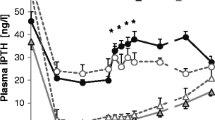Abstract
We investigated the influence of calcium ions on the secretion of anterior pituitary hormones basally and in response to exogenous hypothalamic releasing factors in 6 men with pituitary tumors. To this end, concentrations of LH, FSH, TSH, growth hormone and prolactin were measured in blood collected at 10-min intervals basally and during a continuous infusion of combined TRH (2 μg/min) and GnRH (1 μg/min). Study sessions were randomized to iv saline, calcium, or diltiazem infusions or oral diltiazem administration. Our results indicate that in contrast to responses in normal men, iv calcium injections do not suppress circulating prolactin concentrations in patients with prolactin-secreting pituitary tumors. Moreover, neither oral diltiazem administration for one week nor acute iv diltiazem infusion suppressed the hyperprolactinemia of tumor patients. However, there were significant effects of drug and calcium treatments on serum concentrations of FSH, GH and testosterone, but not LH or TSH. Moreover, during GnRH-TRH stimulation, there were significant differences in LH, TSH, and testosterone responses in tumor patients compared to normal men. In summary, iv calcium infusion was associated with invariant basal release of anterior pituitary tumoral hormones in patients with pituitary adenomas. However, there were significant differences in the GnRH/TRH-stimulated release of certain anterior pituitary hormones in tumor patients compared to normal men in response to iv calcium and the calcium-channel antagonist, diltiazem.
Similar content being viewed by others
References
Borges J.L.C., Scott D., Kaiser D.L., Evans W.S., Thorner M.O. Ca+2 dependence of gonadotropin-releasing hormone-stimulated luteinizing hormone secretion: in vitro studies using continuously perifused dispersed rat anterior pituitary cells. Endocrinology 113: 557, 1983.
Conn P.M., Rogers D.C., Sandhu F.S. Alteration of the intracellular calcium level stimulates gonadotropin release from cultured rat anterior pituitary cells. Endocrinology 105; 1122, 1979.
Jutisz M., Paloma de la Llosa M. Requirement of Ca++ and Mg++ ions for the in vitro release of follicle-stimulating hormone from rat pituitary glands and in its subsequent biosynthesis. Endocrinology 86: 761, 1969.
Marian J., Conn P.M. Gonadotropin releasing hormone stimulation of a cultured pituitary cells requires calcium. Mol. Pharmacol. 16: 196, 1979.
Conn P.M., Marian J., McMillian M., Rogers D. Evidence for calcium mediation of gonadotropin releasing hormone action in the pituitary. Cell. Calcium 1: 7, 1980.
Bourne G.A., Baldwin D.M. Extracellular Ca++-independent and dependent components of the biphasic release of LH in response to lutenizing hormone-releasing hormone in vitro. Endocrinology 107: 780, 1980.
Bigdeli H., Snyder P.J. Gonadotropin-releasing hormone release from the rat hypothalamus: Dependence on membrane depolarization and calcium influx. Endocrinology 103: 281, 1978.
Kaplan E.L., Rubenstein A.H., Evans R., Lee C.H., Klementschitsch P. Calcium infusion: A new provocative test of insulinomas. Ann. Surg. 190: 501, 1979.
Brunt L.M., Veldhuis J.D., Dilley W.G., Farndon J.R., Santen R.J., Leight G.S., Wells S.A. Stimulation of insulin secretion by a rapid intravenous calcium infusion in patients with beta cell neoplasms of the pancreas. J. Clin. Endocrinol. Metab. 62: 210, 1986.
Kaplan E.L., Jaffe B.M., Peskin G.W. A new provocative test for the diagnosis of the carcinoid syndrome. Am. J. Surg. 123: 173, 1972.
Deveney C.W., Deveney K.S., Jaffe B.M., Jones R.S., Way L.W. Use of calcium and secretin in the diagnosis of gastrinoma (Zollinger-Ellison Syndrome). Ann. Intern. Med. 87: 680, 1977.
Wells S.A., Baylin S.B., Linehan W.M., Farrell R.E., Cox E.B., Cooper C.W. Provocative agents and the diagnosis of medullary carcinoma of the thyroid gland. Ann. Surg. 188: 139, 1978.
Veldhuis J.D., Borges J.L.C., Drake C.R., Rogol A.D. Divergent influences of calcium ions on releasing factor-stimulated anterior pituitary hormone secretion in normal man. J. Clin. Endocrinol. Metab. 59: 56, 1984.
Dudczak R., Waldhausl W.K., Bratusch-Marrain P. Effects of disodium EDTA and calcium infusion on prolactin and thyrotropin responses to thyrotropin-releasing hormone in healthy man. J. Clin. Endocrinol. Metab. 56: 603, 1983.
Ajlouni K., Khateeb M.E. The effect of acute hypercalcemia on prolactin release in man. Horm. Metab. Res. 13: 282, 1981.
Rojdmark S. Prolactin release in man: influence of Cimetidine, thyrotrophin-releasing hormone and acute hypercalcemia. Endocrinologica 102: 481, 1983.
Schlach D.S., Parker M.L. A sensitive double antibody immunoassay for human growth hormone in plasma. Nature 203: 1141, 1964.
Thorner M.O., Martin W.H., Rogol A.D., Morris J.L., Perryman R.L., Conway B.P., Howards S.S., Wolfman M.J., MacLeod R.M. Rapid regression of pituitary prolactinomas during bromocriptine treatment. J. Clin. Endocrinol. Metab. 51: 438, 1980.
Evans W.S., Rogol A.D., MacLeod R.M., Thorner M.O. Dopaminergic mechanisms and luteinizing hormone secretion. Acute administration of the dopamine agonist bromocriptine does not inhibit luteinizing hormone release in hyperprolactinemic women. J. Clin Endocrinol. Metab 50: 103, 1980.
Wien R.E., Runser D.J., Troschang A.J., Dimmitt D.C. Determination of diltiazem and desacetyl-diltiazem in plasma by HPLC. 33rd National Meeting of the American Pharmacological Association Academy of Pharmaceutical Science, Washington, D.C., p. 176, Abstract No. 33, 1982.
Veldhuis J.D., Borges J.L.C., Drake C.R., Rogol A.D., Kaiser D.L., Thorner M.O. Divergent influences of the stucturally dissimilar calcium entry blockers, diltiazem and verapamil, on thyrotropinand gonadotropin-releasing hormone-stimulated anterior pituitary hormone secretion in man. J. Clin. Endocrinol. Metab. 60: 144, 1985.
Author information
Authors and Affiliations
Additional information
Visiting Fellow in the Laboratory of Dr. M.O. Thorner supported in part by CABES, Brazil.
Rights and permissions
About this article
Cite this article
Davis, M., Nassberg, B., Borges, J.L.C. et al. Actions of calcium ions and a calcium-influx blocker on basal and TRH- and GnRH-stimulated hormone release in patients with pituitary adenomas. J Endocrinol Invest 10, 427–433 (1987). https://doi.org/10.1007/BF03348164
Received:
Accepted:
Published:
Issue Date:
DOI: https://doi.org/10.1007/BF03348164




